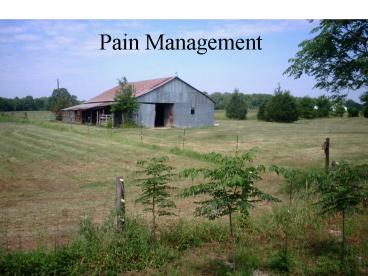Pain Management - PowerPoint PPT Presentation
1 / 13
Title: Pain Management
1
Pain Management
2
Pain Classification
- Acute Pain
- up to 3 days after injury
- also defined as up to several months after an
injury
- Chronic Pain
- gt several months
3
Substance P
- Chemical mediator thought to be involved with
transmission of pain. - Associated with inflammatory pain
- It excites pain transmitting neurons when
released - Its mechanism is not fully understood
4
Gate Control Theory - Melzack Wall 1965
- severity of pain sensation determined by balance
between excitatory and inhibitory inputs to T
cells in spinal cord - C A-delta nociceptor afferents give excitatory
input - Substantia gelatinosa, large diameter A-beta
non-nociceptor afferents give inhibitory input - Increased firing of non-nociceptor afferents
causes presynaptic inhibition of T cells and the
spinal gate from excitatory cells to the brain is
closed. - Physical agent modalities and physical activities
believed to close the gate by activating the
non-nociceptor afferents - The theory does not explain pain modulation
descending from brain
5
Endorphins
- Pain perception modulated by these opiate like
neurotransmitters - The endorphins bind to certain sites on the
nervous system including peripheral nerves - They suppress pain transmission at the spinal
cord level by inhibiting the release of the
neurotransmitter gamma aminobutyric acid (GABA)
in the periaqueductal gray matter (PAGM) raphe
nucleus of the brain - High concentration of opiate receptors in limbic
area of brain explains the stress relief and
euphoria associated with opiates - Limbic system involved with emotional component
of pain
6
Pain Scales
- 0 to 10 scale
- these scales may not be reliable since pain
perception differs in various people - Observable characteristics of pain
- palpation
- mild, moderate, severe
- anesthesiometer
- Ability to complete ADLs such as makeup
7
Psychological aspects of pain
- learned responses
- emotional components
- associated pain
- random pains attributed to injury
- Reaction to stressors
- work
- family
- marriage
8
Autonomic nervous system
- parasympathetic
- activates smooth muscles, cardiac muscles, and
glandular secretions - Sympathetic
- involved in flight or fight response
- manages blood pressure, heart rate, constricts
blood vessels, increases sweating - this system responds to injury temporarily
- stimulation here does not usually cause pain
- over reactive sympathetic response can cause
continued pain - Stressors and emotional events seem to affect a
person at this level
9
Pain Syndromes
- RSD
- involves sympathetic nervous system over
activation - Shoulder hand syndrome
- Somatization disorders
- psychological response
- dependent person
- sick role
- external locus of control
- frequently seeks medical attention
- no desire to get better
10
Acute pain management
- NSAIDs - Non-steroidal anti-inflammatory drugs
- aspirin, ibuprofen, Naprosin, Feldene
- may cause kidney damage, bone marrow suppression,
rashes, decrease renal blood flow in dehydrated
pts - Acetaminophen (Tylenol)
- has analgesic antipyretic effect, but no
anti-inflammatory effect - prolonged use can cause liver damage
- physical agents
- light exercise
- corticosteroid injections
11
Chronic Pain Management
- No physical agent modalities
- develop internal locus of control
- train them to take control of their
responsibilities - occupationally relevant activities
- no passive treatments
- require them to resume responsibilities
- stressor management
- marriage or family counseling
- change jobs
12
(Chronic Pain Management Cont.)
- Distraction techniques
- relaxation techniques
- problem solving training
- behavior modification
13
Handling your emotions
- Realize that these are difficult patients
- Realize that they need help even though it
doesnt seem that way - Dont take it personally
- Realize that most of these patients you will not
cure. Your goal is to manage them. - Dont talk about how they feel. You already know
that.































